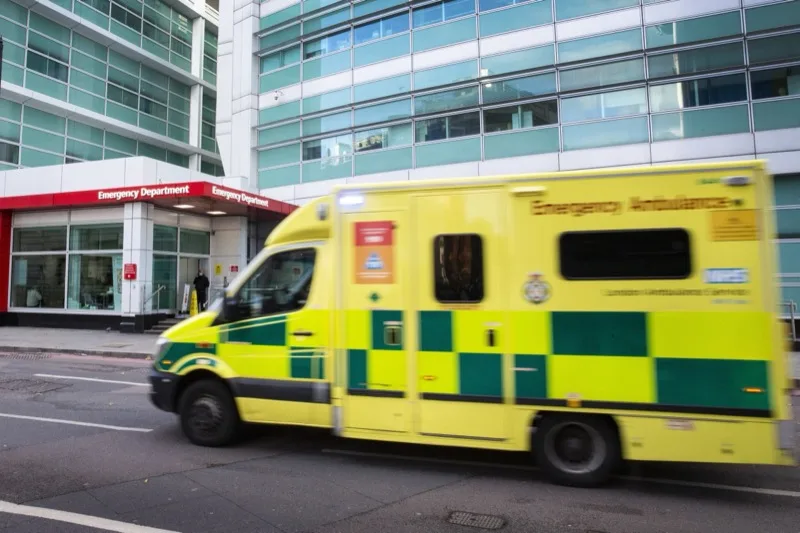
NHS staff faced the busiest week for ambulances so far this winter with more than 93,500 arriving at hospitals to hand over patients, alongside significant performance improvements.
New weekly data shows that extensive winter NHS planning is continuing to pay off, with hours lost to ambulance handover delays more than halved compared to last year, and more than twice as many NHS 111 calls answered within a minute compared to last year, despite increased demand.
In addition to strike action happening this week, seasonal viruses continue to put pressure on hospitals. There were on average 1,313 patients in hospital with the virus each day during the week ending 31 December. This was up by more than a third on the week before (942), and a five-fold increase from a month ago (243).
Of those in hospital with flu last week, 81 were in critical care – up nearly 70% from the previous week (48).
Separate figures show the number of patients in hospitals with Covid is up 72% in a month, with an average 3,929 people in hospitals across England with the virus each day in the last week of 2023 – up from 2,290 in the week ending 30 November.
The number of people in hospital with norovirus continues to fall, with 378 in hospital each day last week – down from 452 the week before.
Thanks to extensive winter plans and the NHS blueprint to recover urgent and emergency care, ambulance handovers have significantly improved compared to last winter.
Latest figures show hours lost to handover delays were 56% lower than same time last year (24,384, compared with 54,853), despite last week being the busiest so far this winter for ambulance arrivals at hospital (93,576).
It was also the busiest week for calls to NHS 111 so far this winter, with 444,285 calls answered, almost 34,000 more than same week last year. Despite the high demand there have been significant improvements in answer times, with call handlers answering almost two-thirds (62%) within a minute compared to 26% last year.
In the run-up to the holidays, staff did all they could to get as many patients as possible home for Christmas, and the latest data shows last week there was an average of 11,478 people each day in hospital who could not be discharged despite being medically ready, a slight increase on the week before (11,439) but fewer patients than the same week last year (12,809).
Overall adult bed occupancy is the lowest it has been so far this winter – 91% – a combination of efforts to discharge patients in time for Christmas, and preparing for and managing industrial action. In a letter to trusts ahead of the industrial action by junior doctors in December, acute trusts were asked to aim to reduce occupancy as far as possible in anticipation of reduced staffing levels.
Robust NHS planning for winter began earlier than ever before, including the nationwide rollout of care ‘traffic control’ centres, extra ambulances and beds, more NHS call handlers, and the rapid expansion of the world-leading virtual wards programme, helping keep patients out of hospitals and treating more people at home and in the community.
The new figures are published in the midst of the longest ever consecutive strike action taken in the history of the NHS, with strikes by junior doctors starting on Wednesday (3 January), and continuing until 7am on Tuesday 9 January.
The strikes are set to have a significant impact on almost all routine care, with consultants covering as the NHS prioritises urgent and emergency cases.
Since strikes began, the cumulative total of acute inpatient and outpatient appointments rescheduled is now 1,219,422.
Professor Julian Redhead, NHS England’s National Clinical Director for Urgent and Emergency Care, said: “These new figures are testament to the incredible hard work of NHS staff who are continuing to deliver for patients and make significant progress on our winter plans, despite ongoing demand for emergency care, increasing levels of winter viruses, and in a week that included the Christmas period – we know demand always increases following a bank holiday, but this time it also followed another round of industrial action from junior doctors, adding further pressure to services.
“And we know the pressure is not going to let up any time soon, with four more days left of the longest ever consecutive strike action taken in the history of the NHS, and flu season not expected to peak in the near future – in one week alone the number of patients in ICU with flu jumped up by 70% and the number of patients in hospital with Covid continues to rise, which is a real concern, and we are seeing much sicker, higher acuity patients coming forward for care.
“Although we have extensive preparations in place for strikes, and emergency care will continue to be prioritised, there is no denying the NHS has started the year in a very difficult position – this latest round of strike action will not only have an impact on this week but will have an ongoing effect on the weeks and months ahead, as we struggle to recover services and cope with heavy demand, but as ever I would urge the public to get their flu and Covid vaccines if they are eligible, and continue to use 999 or A&E in an emergency, and 111 online for any other conditions.”
Staff absences have improved on the week before, with an average of 47,779 staff off each day during the last week of the year (down from 49,552 in the week ending December 24), with fewer staff off due to Covid each day last week (2,378) compared with the previous week (2,597).















